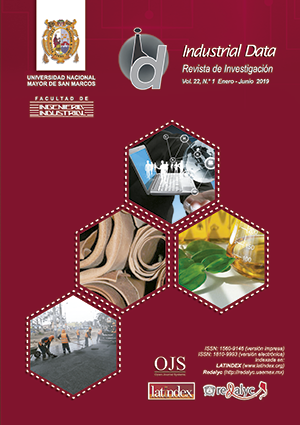Kinetic study of bioethanol production from agroindustrial residues of ripe banana peel
DOI:
https://doi.org/10.15381/idata.v22i1.16534Keywords:
Banana peel; polyethylene glycol; enzymatic hydrolysis; alcoholic fermentation; bioethanolAbstract
This research addresses the application of compound polyethylene glycol (PEG) of molecular weight 1500, whose objective is to degrade the inhibiting compounds present during the enzymatic hydrolysis of Cavendish variety ripe banana peels. Likewise, three experiments were conducted on 60% ground banana peel, to which PEG was added at different concentrations: 0.01; 0.02; and 0.03 g/g biomass. The enzymatic hydrolysis was performed with conidia of the Trichoderma viride fungus and its subsequent alcoholic fermentation with commercial active dry yeast Saccharomyces cerevisiae, which was previously activated. The best result corresponds to the PEG3 experiment (0.03 g/g biomass), with which a greater increase of reducing sugars was obtained. In addition, significant differences were found (p<0.5) in the glucose obtained among the three hydrolytic treatments. The results show that bioethanol can be obtained from the lignocellulosic residues of ripe banana peel, whose 7% v/v yield obtained is close to others reported in the same field of study. Finally, the analysis of the variable costs of the pretreatment, applied to the banana peel for the production of the ethanol obtained, makes it possible to estimate that the method proposed in this article is less expensive compared to other procedures, demonstrating a higher bioethanol yield obtained in less time.
Downloads
Downloads
Published
Issue
Section
License
Copyright (c) 2019 Hugo Romero Bonilla, Cinthia Macías Balón, Aracelly Palacios Moreno, Felipe Redrovan Pesantez

This work is licensed under a Creative Commons Attribution-NonCommercial-ShareAlike 4.0 International License.
AUTHORS RETAIN THEIR RIGHTS:
a. Authors retain their trade mark rights and patent, and also on any process or procedure described in the article.
b. Authors retain their right to share, copy, distribute, perform and publicly communicate their article (eg, to place their article in an institutional repository or publish it in a book), with an acknowledgment of its initial publication in the INDUSTRIAL DATA.
c. Authors retain theirs right to make a subsequent publication of their work, to use the article or any part thereof (eg a compilation of his papers, lecture notes, thesis, or a book), always indicating the source of publication (the originator of the work, journal, volume, number and date).






